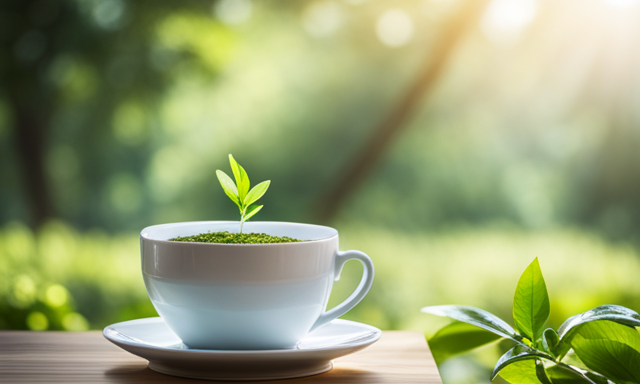Imagine sipping on a cup of tea that transports you to a tranquil garden, where the air is crisp and the grass is vibrant. That’s the experience you can expect when you indulge in the unique taste of green rooibos.
As a tea enthusiast, I am always on the lookout for new and exciting flavors, and green rooibos has quickly become one of my favorites. In this article, I will delve into the world of green rooibos, exploring its origins, cultivation, and most importantly, its flavor profile.
Unlike its red counterpart, green rooibos offers a fresh and grassy taste that is truly refreshing. Whether you’re a tea connoisseur or simply curious about trying something new, join me on this journey as we uncover the delightful taste of green rooibos.
Key Takeaways
- Green rooibos has a mild and slightly sweet taste.
- It has subtle grassy and earthy notes.
- Unlike other herbal teas, green rooibos stands out with its smoothness and lack of bitterness or astringency.
- It provides a great alternative for those who prefer a milder flavor.
A Brief Introduction to Green Rooibos Tea
Green rooibos tea is a variation of the traditional red rooibos tea, but with a milder flavor profile. It undergoes minimal oxidation, giving it a lighter and more delicate taste. This tea is known for its numerous health benefits, such as being rich in antioxidants and minerals. It is also caffeine-free, making it a great choice for those looking for a soothing and calming beverage. Green rooibos comes in different varieties, including blends with fruits or herbs that add additional layers of flavor. Now, let’s explore the origins and cultivation of green rooibos.
The Origins and Cultivation of Green Rooibos
Originating from the mountainous regions of South Africa, green rooibos undergoes a unique cultivation process that includes minimal oxidation, resulting in a distinct flavor profile.
The origins of green rooibos can be traced back to the Cederberg region, where this tea is cultivated and harvested. The plants are carefully grown in sandy soil and are known for their needle-like leaves, which are harvested by hand.
After harvesting, the leaves are quickly steamed to prevent oxidation and then dried. This minimal processing preserves the natural green color and delicate flavor of the tea.
Green rooibos has a fresh and herbaceous taste with subtle floral notes, making it a refreshing and soothing beverage. Its flavor is often described as milder compared to red rooibos.
The difference in taste between green rooibos and red rooibos will be explored in the subsequent section.
The Difference in Taste between Green Rooibos and Red Rooibos
The taste of green rooibos is often described as milder and slightly sweeter compared to red rooibos. It has a light and refreshing flavor with hints of grassy and herbal notes. Green rooibos lacks the strong and robust flavor of red rooibos, making it a popular choice for those who prefer a more subtle and delicate taste. Its natural sweetness pairs well with a variety of flavors, making it a versatile ingredient in herbal blends and infusions. Green rooibos is also known for its smooth and clean finish, making it a popular choice for those who enjoy a lighter and less intense cup of tea.
Overall, the difference in taste between green rooibos and red rooibos offers a range of options for tea lovers to explore and enjoy. Whether you prefer the bold and sweet flavors of red rooibos or the milder and refreshing taste of green rooibos, both varieties provide a unique and satisfying tea experience.
The Flavor Profile of Green Rooibos
The flavor profile of green rooibos is a refreshing bouquet of floral and herbal notes that dance on your palate. With each sip, you are greeted by the invigorating taste of fresh and floral notes.
It’s like taking a stroll through a blooming garden, with hints of delicate flowers lingering in the air. The herbal and refreshing taste of green rooibos is truly unique, offering a soothing and rejuvenating experience.
It’s like sipping on a cup of nature’s goodness, with its vibrant flavors and invigorating aroma. As you savor this delightful tea, you can’t help but appreciate the notes of freshness and grassiness in green rooibos, making it a perfect choice for those seeking a natural and invigorating beverage.
Notes of Freshness and Grassiness in Green Rooibos
Immerse yourself in the sensory experience of green rooibos as you indulge in its crisp and earthy notes, evoking images of a dew-covered meadow on a tranquil morning.
The freshness notes of green rooibos are unmistakable, infusing each sip with a vibrant and invigorating character. It is as if you can taste the essence of freshly cut grass, bringing a rejuvenating energy to your palate.
The grassy flavor of green rooibos adds a delightful complexity, adding depth and dimension to the overall taste. This unique combination of freshness and grassiness creates a truly refreshing and revitalizing tea experience.
As we explore further, we will discover the subtle sweetness and earthy undertones in green rooibos that harmonize perfectly with its vibrant and grassy nature.
Subtle Sweetness and Earthy Undertones in Green Rooibos
Transitioning from the previous subtopic of the notes of freshness and grassiness in green rooibos, let’s now delve into the subtle sweetness and earthy undertones that make this tea truly unique.
When it comes to enhancing the subtle sweetness of green rooibos, infusion techniques play a crucial role. By using slightly cooler water and shorter steeping times, you can preserve the delicate flavors and prevent any bitterness from overpowering the sweetness. Additionally, experimenting with different sweeteners such as honey or agave can complement and accentuate the natural sweetness of the tea.
Beyond its taste, green rooibos also holds potential health benefits within its earthy undertones. Rich in antioxidants and polyphenols, this tea may boost immune function, reduce inflammation, and support heart health. Its earthy notes add a grounding element, making each sip a comforting and rejuvenating experience.
Now, let’s move on to the next section where we will explore how to brew green rooibos for the best flavor and aroma, ensuring a truly delightful tea-drinking experience.
How to Brew Green Rooibos for the Best Flavor
To truly savor the nuanced flavors of green rooibos, one must master the art of brewing. This involves allowing the leaves to dance and release their aromatic symphony into the cup. Brewing techniques play a crucial role in unlocking the full potential of this tea.
Start by using fresh, filtered water heated to about 180°F (82°C). This temperature ensures a gentle extraction of the delicate flavors. Steep the leaves for about 5 minutes to achieve the perfect balance. The recommended steeping time may vary slightly depending on personal preference, but be cautious not to oversteep, as it can lead to a bitter taste.
The resulting infusion will showcase green rooibos’ subtle sweetness and earthy undertones. Pairing green rooibos with food and desserts enhances the overall experience without overpowering its delicate flavors.
Pairing Green Rooibos with Food and Desserts
Enhance your green rooibos experience by indulging in the perfect pairing of food and desserts. Allow the flavors to harmonize and create a culinary symphony in your mouth.
Green rooibos has a delicate and slightly sweet flavor profile that pairs well with a variety of dishes. For a light and refreshing meal, try pairing a cup of green rooibos with a fresh salad or grilled vegetables. The earthy notes of the tea complement the crispness of the greens perfectly.
If you have a sweet tooth, consider pairing green rooibos with fruity desserts like berry tarts or lemon pound cake. The natural sweetness of the tea enhances the flavors of the fruits, creating a delightful combination.
For more adventurous pairing suggestions and green rooibos recipes, continue reading to discover the health benefits of green rooibos.
Health Benefits of Green Rooibos
One sip of green rooibos is like a refreshing breeze on a hot summer day, gently cooling and invigorating your body. Not only does this delightful tea offer a unique taste experience, it also provides numerous health benefits.
Green rooibos is packed with antioxidants, which help to protect your body against free radicals and reduce the risk of chronic diseases. It is also rich in minerals such as potassium, calcium, and magnesium, which are essential for maintaining a healthy body.
When it comes to brewing techniques, green rooibos requires a lower temperature and shorter steeping time compared to its red counterpart. This ensures a milder flavor and a smoother finish.
So, embrace the unique taste of green rooibos and enjoy its many health benefits.
Conclusion: Embrace the Unique Taste of Green Rooibos
So why not give in to the allure of the one-of-a-kind flavor found in green rooibos and experience its refreshing benefits for yourself?
Green rooibos offers a taste that is truly unique and unlike any other herbal tea. It has a mild and slightly sweet flavor with subtle grassy and earthy notes.
When compared to other herbal teas, green rooibos stands out for its smoothness and delicate taste. It lacks the bitterness and astringency often found in green teas, making it a great alternative for those who prefer a milder flavor profile.
Exploring alternative green teas can be an exciting journey, and green rooibos is definitely one that should not be missed. So go ahead and embrace the distinct taste of green rooibos and discover its refreshing and enjoyable qualities.
Frequently Asked Questions
Can green rooibos be used as a substitute for red rooibos in recipes?
Green rooibos can be a delightful substitute for red rooibos in recipes. Its vibrant, earthy flavor adds a refreshing twist. Plus, it boasts numerous health benefits, making it a smart choice for both taste and wellness.
Does green rooibos contain caffeine?
Green rooibos does not contain caffeine. It offers numerous health benefits, such as being rich in antioxidants and supporting digestion. The main difference between green and red rooibos lies in their processing methods.
How long does green rooibos stay fresh?
Green rooibos has a long shelf life and can stay fresh for up to two years if stored properly. It is important to keep it in an airtight container away from light, heat, and moisture to maintain its quality.
Can green rooibos be consumed hot and cold?
Yes, green rooibos can be enjoyed hot or cold. It offers numerous health benefits, including being rich in antioxidants and supporting digestion. To prepare, steep the leaves in hot water or brew a refreshing iced tea.
Are there any potential side effects of drinking green rooibos?
There are no known potential side effects of drinking green rooibos. It is believed to have numerous potential health benefits. However, it is important to consume it in moderation and not exceed the recommended daily intake.
Conclusion
After exploring the fascinating world of green rooibos tea, I must say, I’m hooked! The unique taste of this refreshing beverage is like a breath of fresh air. It has notes of freshness and grassiness that dance on your palate. It’s like a cool breeze on a warm summer day – invigorating and revitalizing.
Brewing green rooibos is a breeze, and it pairs perfectly with a variety of foods and desserts. Plus, the health benefits are just the cherry on top.
So go ahead, embrace the deliciously distinct flavor of green rooibos and let it transport you to a world of taste sensations!










